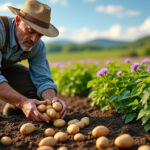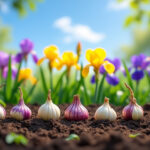Understanding the optimal timing for harvesting spring onions is essential for every aspiring gardener. The nuances of when to pick these delightful, green stalks can significantly influence their flavor and texture, making it a pivotal aspect of gardening. Whether it’s the casual home gardener or the dedicated professional, the knowledge of when and how to harvest spring onions holds great value. With their growing popularity in kitchens worldwide, mastering the harvest of these versatile vegetables can enhance culinary experiences. Below, discover comprehensive insights into the timing, methods, and considerations for a successful spring onion harvest.
- Understanding Spring Onion Growth 🌱
- When to Harvest for Maximum Flavor ⏰
- Harvesting Techniques for Optimal Result ✂️
- Storing Your Spring Onions Properly 🏡
- Processing and Benefits of Fresh Spring Onions 🌟
Understanding Spring Onion Growth
The cultivation of spring onions, or Allium fistulosum, offers a rewarding experience for gardeners. These hardy plants require minimal maintenance and can thrive almost year-round. Typically, spring onions can be sown from spring through autumn. However, autumn sowing is regarded as particularly effective for an early harvest the following spring. Specialized planting techniques, such as using plastic growing trays, allow for well-structured development of individual seedlings, optimizing growth factors.
This means creating sufficient space between seedlings for optimal growth. The first indications of readiness for harvest can often be seen in the height of the plants, with younger stalks generally being preferred for their tenderness. Additionally, harvest timing can vary based on planting conditions. For example, successful cultivators might utilize a mix of sowing methods to produce continuous yields throughout the season.
When to Harvest for Maximum Flavor
Spring onions are typically harvested based on their height and developmental milestones. The most favorable indicators include:
- ⚖️ Green tops reaching about 6 inches (15 cm) to be enjoyed as green onions.
- 🔍 For fuller flavor, waiting until the stalks are 10-12 inches (25-30 cm) is ideal.
- 🌞 The best time for harvesting is in the coolness of the morning, when the soil is moist.
Timing plays an essential role in ensuring both the taste and texture are at their peak. Over-maturity can lead to tough, woody onions that depart from the delightful crunch sought after in culinary use.
Harvesting Techniques for Optimal Result
When it comes time to gather these vibrant vegetables, employing the right technique is crucial. Here are several methods for harvesting that can ensure the quality of the produce:
| Method | Description |
|---|---|
| 🌿 Hand Pulling | Gently grasp the base of the onion and pull straight up. Ensure not to disturb surrounding plants. |
| ⚒️ Using Tools | A garden trowel or pitchfork can help loosen the soil before pulling the onions out, reducing the risk of bruising. |
| ✂️ Cutting | Use scissors to snip the green tops, leaving 1-2 inches of the shaft in place for continued growth. |
Once harvested, properly handling the onions is essential. Removing excess soil using gentle shaking or by brushing with a soft cloth helps maintain their integrity until they are ready to be processed.
When to harvest onions for the best flavor and storage
Storing Your Spring Onions Properly
To prolong freshness after harvest, spring onions must be cured correctly. Follow these steps for ideal storage:
- 🌬️ Spread harvested onions in a well-ventilated area to dry for at least 2-3 weeks.
- 📦 Store dried onions in a cool, dry spot at temperatures between 32-40°F (0-4°C).
- 💧 Maintain humidity levels around 65-70% to prevent spoilage.
Properly cured and stored onions can last several months, enhancing your culinary endeavors with homegrown flavors year-round. Freshness is key; consume your spring onions quickly for the best taste!
Processing and Benefits of Fresh Spring Onions
Integrating fresh spring onions into meals not only enhances flavor but also brings numerous health benefits. The nutritional advantages include:
- 💚 Packed with vitamins, particularly vitamin C and K.
- 🌿 A low-calorie addition that enhances the general appeal of meals.
- 🔥 Known to have anti-inflammatory properties.
Whether utilized in salads, soups, or as a garnish, these onions add vibrant texture and taste. Furthermore, fresh spring onions can be incorporated into a variety of dishes, appealing to diverse culinary traditions.
Frequently Asked Questions
- What is the best time of year to plant spring onions?
They can be planted from spring to autumn, with autumn sowing offering early spring harvests. - How can I tell if my spring onions are ready?
When they reach around 6-12 inches in height and begin to brown at the top, they are ready for harvest. - Can I store spring onions for a long time?
Yes, with proper curing and storage techniques, they can last for several months.
A successful spring onion harvest not only enriches the kitchen experience but also serves as a testament to the rewarding practice of gardening. Whether from seed or set, the journey from garden to table is undoubtedly worthwhile.









